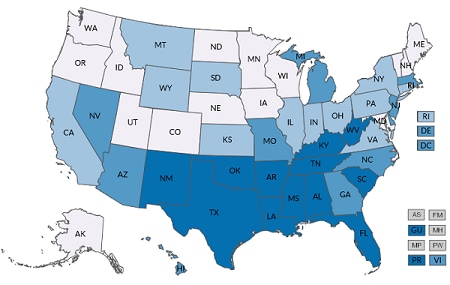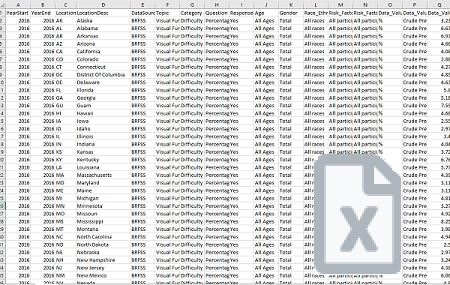Prevalence of Diabetic Retinopathy (DR)
DR Composite Prevalence Estimates at a Glance
| Data Type | Predicted prevalence rates and prevalence counts created using a statistical modeling approach. |
|---|---|
| Source Data |
|
| Case Definition |
|
| Year | Released 2023, estimates based on 2021 population estimates. |
| Publications | JAMA Ophthalmology article |
| Suggested Citations | Lundeen EA, Burke-Conte Z, Rein DB, Wittenborn JS, Saaddine J, Lee AY, Flaxman AD. JAMA Ophthalmology. 2023; online ahead of print. |
Overview
The Vision and Eye Health Surveillance System (VEHSS) composite prevalence estimate of DR is CDC’s primary estimate of the prevalence of DR in the United States. VEHSS researchers used a statistical method called Bayesian meta-regression to combine information from multiple data sources available in VEHSS to produce DR prevalence estimates among the entire US population in 2021. VEHSS includes crude and standardized estimates (standardized to the national age, gender, and race/ethnicity distribution).
Case Definition:
DR is defined as having vision-threatening or non-vision threatening DR, as measured using the retinal imaging module of the National Health and Nutrition Examination Survey (NHANES).
- Vision-Threatening DR: includes severe non-proliferative DR, proliferative DR, and diabetic macular edema in either eye.
- Non-Vision-Threatening DR: includes mild or moderate non-proliferative DR in either eye, and no vision threatening DR in either eye.
Overall Findings
- In 2021 across all ages, an estimated 9.6 million people in the United States were living with diabetic retinopathy (DR).
- Of these, 1.84 million were living with vision-threatening DR.
- Among people with diabetes, the prevalence rate of DR was lowest among people younger than age 25 at 13.0% and highest among the 65-79 age group at 28.4%.
- There were 8.94 million people aged ≥40 years with DR and 1.71 million people aged ≥40 years with vision threatening DR.
- Non-Hispanic blacks had the highest prevalence rate of DR (3.26%) and vision-threatening DR (1.11%).
- The prevalence rate was higher among males than females for DR (0.64% vs. 0.47%) and vision-threatening DR (2.74% vs 1.94%).
- DR prevalence varied substantially at state and county levels even after accounting for differences in demographics.
- By state, the crude prevalence rate of DR among people with diabetes ranged from a low of 20.8% in Nevada to a high of 31.3% in Massachusetts.
National Results:
Table 1. Prevalence of Diabetic Retinopathy (DR) in 2021, (95% Uncertainty Interval)
| Non-Vision-Threatening DR |
Vision-Threatening DR |
Any DR |
|
|---|---|---|---|
| Overall National | 7,765,000 (6,015,000 – 9,712,000) | 1,838,000 (1,406,000 – 2,400,000) | 9,603,000 (7,905,000 – 11,555,000) |
| Female | 3,256,000 (2,450,000 – 4,225,000) | 784,000 (586,000 – 1,031,000) | 4,040,000 (3,239,000 – 5,009,000) |
| Male | 4,510,000 (3,301,000 – 5,868,000) | 1,053,000 (779,000 – 1,414,000) | 5,563,000 (4,381,000 – 6,977,000) |
| Black (Non-Hispanic) | 1,366,000 (887,000 – 1,958,000) | 464,000 (310,000 – 672,000) | 1,830,000 (1,339,000 – 2,392,000) |
| Hispanic | 1,395,000 (900,000 – 2,052,000) | 455,000 (295,000 – 660,000) | 1,851,000 (1,339,000 – 2,488,000) |
| White (Non-Hispanic) | 4,437,000 (3,043,000 – 6,126,000) | 753,000 (461,000 – 1,168,000) | 5,190,000 (3,840,000 – 6,895,000) |
| Other race/ethnicity | 567,000 (241,000 – 980,000) | 164,000 (74,000 – 303,000) | 731,000 (442,000 – 1,121,000) |
| 0-17 Years | 30,000 (10,000 – 114,000) | 2,000 (1,000 – 5,000) | 33,000 (11,000 – 117,000) |
| 18-39 Years | 510,000 (342,000 – 722,000) | 125,000 (86,000 – 176,000) | 634,000 (453,000 – 844,000) |
| 40-64 Years | 3,812,000 (2,771,000 – 4,971,000) | 974,000 (705,000 – 1,320,000) | 4,786,000 (3,777,000 – 6,028,000) |
| 65-84 Years | 3,171,000 (2,199,000 – 4,310,000) | 697,000 (487,000 – 973,000) | 3,868,000 (2,936,000 – 5,073,000) |
| 85+ Years | 242,000 (144,000 – 370,000) | 39,000 (23,000 – 61,000) | 282,000 (182,000 – 415,000) |
Figure 1. Percentage of 2021 US Resident Population With Diabetic Retinopathy (DR), by Stage and Age Group
Figure 2. Percentage of 2021 US Resident Population with Diabetic Retinopathy (DR), by Stage and by Gender and Race/Ethnicity
Figure 3. Crude or Adjusted Percentage of 2021 US Resident Population with Any Diabetic Retinopathy (DR) or Vision Threatening DR, by County
*“Crude Prevalence” reports the actual estimated prevalence of diabetic retinopathy (DR) per county. “Adjusted Prevalence” reports county level estimates standardized to the 2010 US population by age, race/ethnicity, and sex. Adjusted Prevalence shows county-level variation in diabetic retinopathy (DR) that is not explained by differences in the population distribution by age, race/ethnicity, or sex across counties.
- State-level national map of DR prevalence rates
- County-level national map of DR prevalence rates, Filtered to Data Type: Adjusted Prevalence (national age, race/ethnicity and gender population) and Risk Factor: Diabetes
- Comparison of national prevalence of DR by vision threatening status, Filtered to Gender: Female and Risk Factor: Diabetes
Stage
Stage
- Any DR
- Vision-threatening DR
- Non-vision-threatening DR
- Any DR
- Vision-threatening DR
- Non-vision-threatening DR
Risk Factor
Risk Factor
- Diabetes
- All persons
- Diabetes
- All persons
Age Group
Age Group
- All ages
- Detailed age groups (5-year groups)
- Major age groups (0-17, 18-39, 40-64, 65-84, ≥85 years)
- All ages
- Detailed age groups (5-year groups)
- Major age groups (0-17, 18-39, 40-64, 65-84, ≥85 years)
Sex
Sex
- All
- Male
- Female
- All
- Male
- Female
Race/Ethnicity
Race/Ethnicity
- All racial and ethnic groups
- Black (non-Hispanic)
- Hispanic
- White (non-Hispanic)
- Other racial and ethnic groups
- All racial and ethnic groups
- Black (non-Hispanic)
- Hispanic
- White (non-Hispanic)
- Other racial and ethnic groups
Data Type
Data Type
- Crude prevalence
- Adjusted prevalence (adjusted by age, race/ethnicity, and sex)
- Crude prevalence
- Adjusted prevalence (adjusted by age, race/ethnicity, and sex)
| National | State | County |
|---|---|---|
Methods
The VEHSS composite prevalence estimates of DR were generated using a statistical modeling approach called Bayesian meta-regression, which is used to combine information from multiple VEHSS data sources into a single summary estimate. The VEHSS estimates use measured DR based on retinal imaging from the 2005-2008 National Health and Nutrition Examination Survey (NHANES) as the reference point dataset to create output based on the characteristics and performance of the NHANES retinal imaging exam. The population with diabetes was based on 2017-2020 NHANES data, including self-reported diabetes, self-reported use of insulin, or elevated blood hemoglobin A1C levels. In addition to NHANES, the estimation model used population-based study data to provide additional evidence on the prevalence of DR by stage and demographic group, 2018 Medicare claims data to provide evidence on the single-year age trends and regional variation in DR, and 2021 American Community Survey data to estimate the underlying US population at risk for DR. Full details of methods used are available in the publication by Lundeen et al 2023.
Other DR Indicators in the VEHSS Data Explorer
CDC uses the VEHSS composite estimate as the primary estimate to assess the percentage of people with DR in the United States by state, county, and across different age groups, racial and ethnic group, gender and by diabetes status. However, VEHSS also contains several other data sources with prevalence or useful information about DR. Readers should consider all sources when deciding which to use to fit their specific information needs.
Self-Report Measures: VEHSS contains estimates of people who reported that a doctor ever told them they had DR from the National Health Interview Survey. These estimates provide a measure of how many people are aware they have DR, whereas the composite prevalence estimates measure DR whether it is diagnosed or not.
Examination-Based DR: VEHSS contains prevalence estimates of measured DR from NHANES. This is one of the primary inputs into the composite prevalence estimate. These estimates are available in the VEHSS Data Explorer but are only available at the national level, were last collected in 2008, and do not incorporate statistical corrections and adjustments included in the composite prevalence estimates.
Diagnosed DR: The VEHSS Data Explorer also contains information on patients with diagnosed DR from administrative claims data, including Medicare, Medicaid, commercial medical insurance, and managed vision care insurance, in addition to electronic health record registry data from the IRIS Registry. These data use diagnosis codes to measure the percentage of patients in each dataset who had a claim or encounter containing a DR diagnosis code during a calendar year. These datasets provide large samples of millions of patients each and include additional detail on DR prevalence by clinical stages. However, these data sources are convenience samples, will only capture diagnosed and treated DR, and cannot provide nationally representative estimates.
Utilization Measures: The VEHSS Data Explorer contains information on using health services related to DR as coded in insurance claims information from Medicare, Medicaid, commercial medical insurance (MarketScan), and managed vision care (VSP) programs, as well as services included in ophthalmology electronic health records summarized by the IRIS Registry. These estimates measure the proportion of patients who had a DR diagnosis during a calendar year and received at least one medical service related to DR treatment, including anti-vascular endothelial growth factor (anti-VEGF) injections.
Summary
The VEHSS Composite Estimates of DR are CDC’s estimate of the percentage of US residents who have DR, where they live, and who they are. These estimates are based on data that identify DR by retinal imaging and therefore represents total prevalence and not just diagnosed prevalence, such as would be measured in a self-report survey, or in claims data. Users should consider the differences in available measures when determining the most appropriate resource to answer their specific research question.

